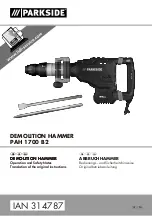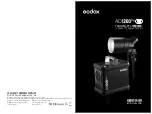
TILTING TABLE
To use the table in a bevel (tilted) position (Fig.24), loosen the table
bevel lock nuts under the table. Tilt the table to the desired angle by
reading the bevel scale. Retighten bevel lock nuts.
WARNING
: To reduce the risk of injury from spinning work or
tool breakage, always clamp workpiece and backup material
securely to the table before operating the drill press with the table
tilted.
To return the table to its original position, loosen the table bevel
lock nuts under the table, tilt the table back to zero on the bevel
scale and retighten table bevel lock nuts under the table.
HOLE LOCATION
Make a dent in the workpiece where you want the hole to be, using
a center punch or a nail. Before turning the switch on, bring the
drill down to the workpiece and line up with the dent in the
workpiece and clamp into place.
FEEDING
Pull down on the feed handles with only enough effort to allow the
drill to cut. Feeding too slowly might cause the drill to burn.
Feeding too rapidly might stop the motor, cause the belt or drill to
slip, tear the workpiece loose or break the drill bit. When drilling
metal, it may be necessary to lubricate the tip of the drill bit with
cutting oil or motor oil to prevent burning of the drill tip.
ADJUSTING THE QUILL RETURN SPRING
NOTE
: The return spring tension is set at the factory and should
not require further adjustment.
1. Keep the chuck at its highest possible position.
2. Lower the table for additional clearance.
3. Work from the left side of the drill press.
4. Place screwdriver in the lower front notch of the spring cap, and
hold it in place while loosening and removing the nut.
5. With screwdriver remaining in the notch, loosen nut (approx.
1/8”) until the notch disengages from the boss on the head. Do
not remove this nut.
6. Carefully turn screwdriver counterclockwise and engage the
next notch in the boss. Do not remove screwdriver.
7. Tighten standard nut with wrench only enough to engage boss.
Do not over tighten as this will restrict quill movement.
8. If there is not enough tension on the spring, repeat steps 4-7
moving only one notch each time and checking tension after
each repetition.
9. Proper tension is achieved when the quill returns gently to the
full up position when released from 3/4” depth.
10. When there is enough tension after checking, tighten nut. Do
not over tighten.
11. Check quill while feeding to have smooth and unrestricted
movement. If movement is too tight, loosen nut until
unrestricted.
ADJUSTMENTS & OPERATIONS
FIGURE 24
Bevel lock
nuts
Table
FIGURE 25
Notch
Boss
Spring
cap
Notch
Nut
Adjustable
wrench

































